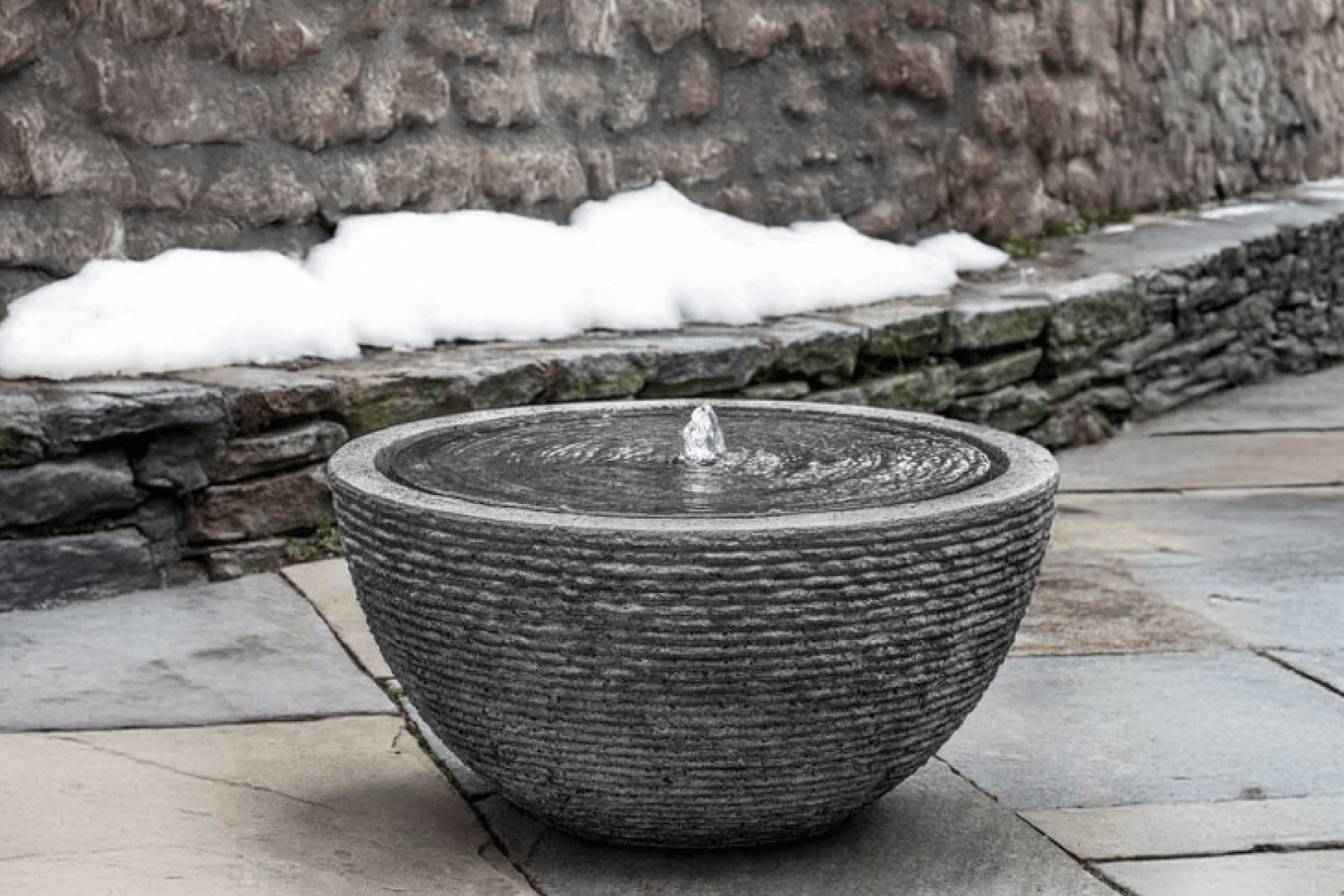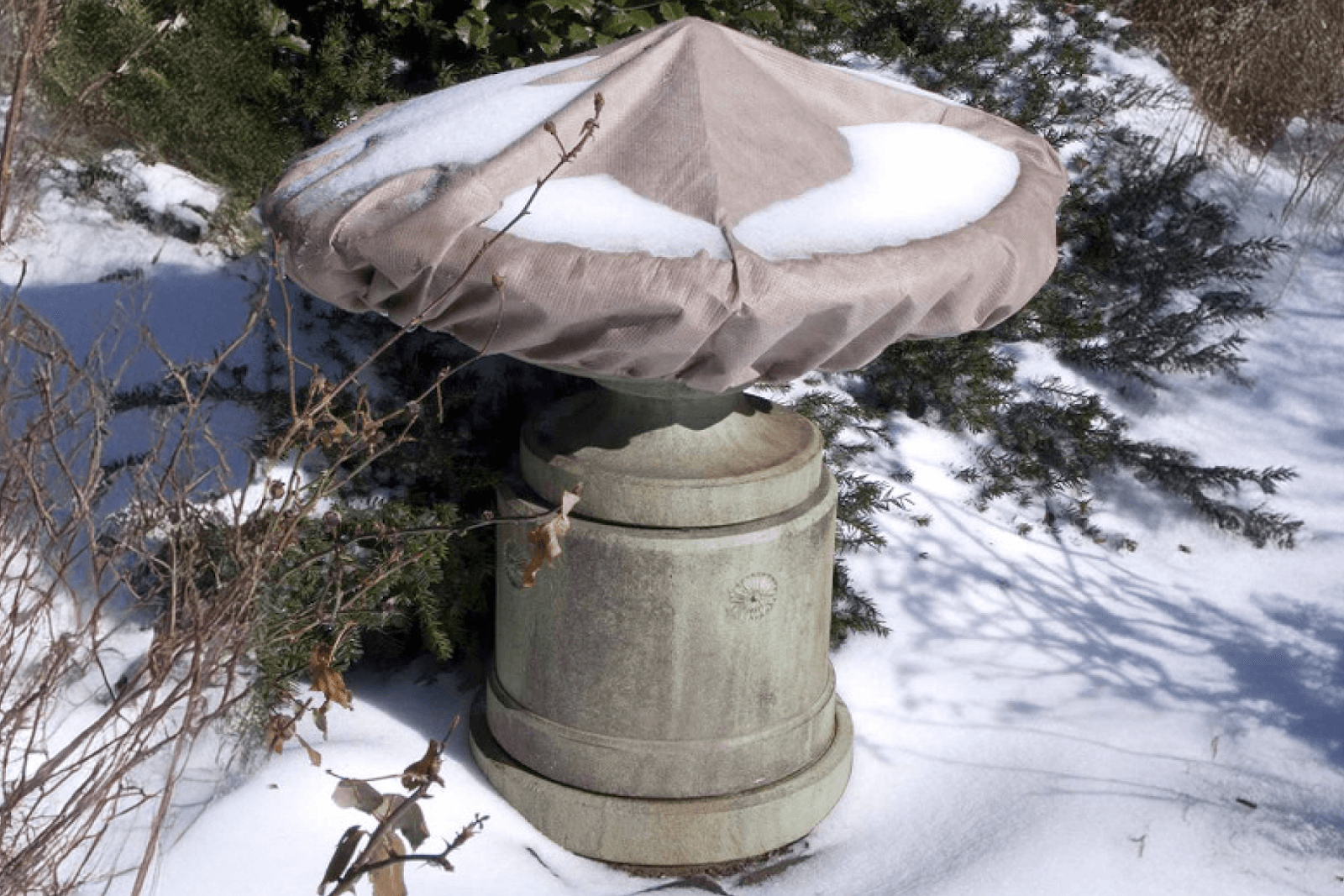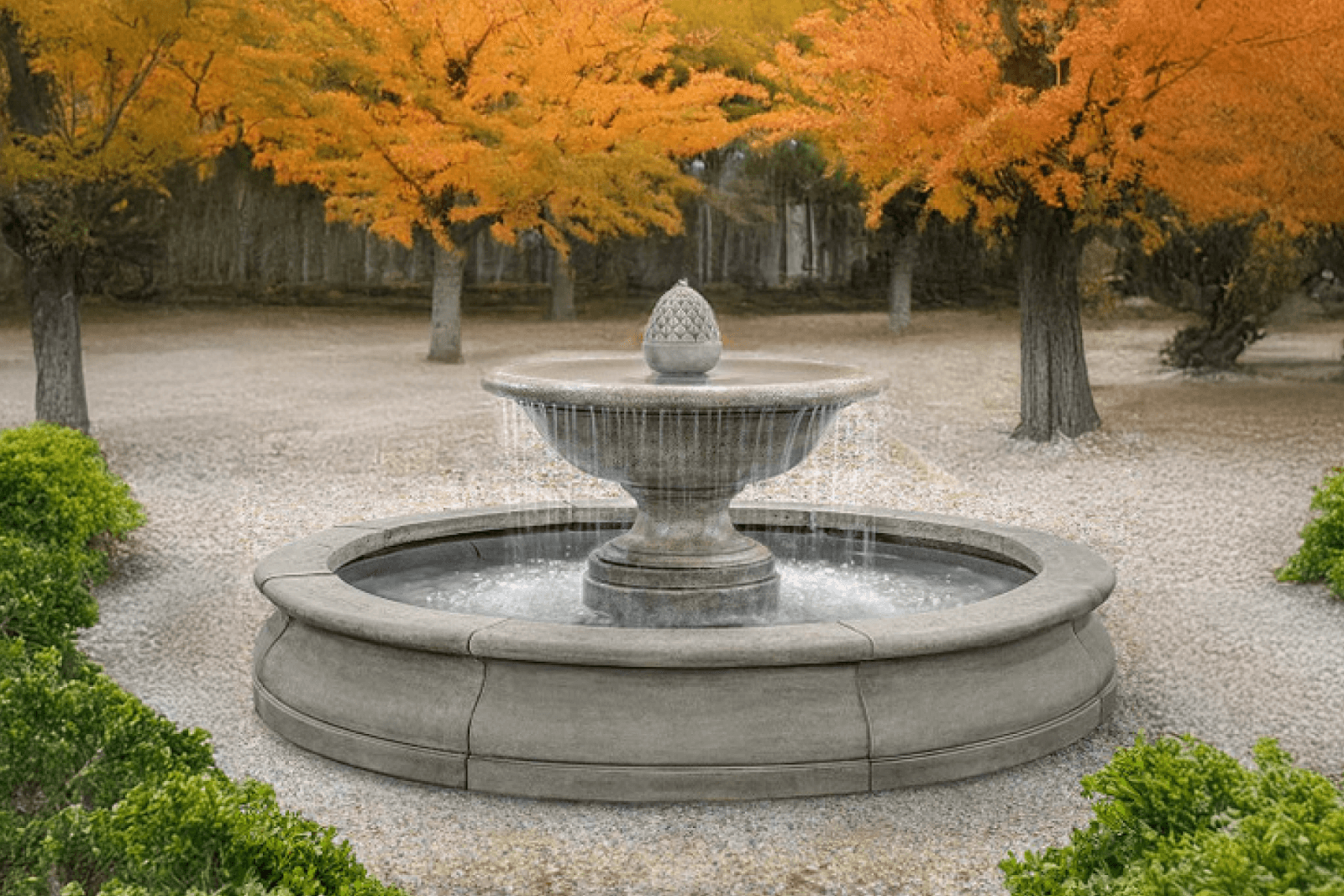As the cold months approach, garden fountains, wall fountains, and other water features need extra attention to survive harsh winter conditions. Whether you live in a region that experiences light frost or heavy snow, winterizing a fountain is essential to preserving its beauty and functionality.
This guide will provide everything you need to know about winterizing your fountain and keeping it safe from freezing—and sometimes below-freezing—temperatures.
Understanding Different Types of Fountains
Not all fountains function the same, and winterizing can vary depending on the fountain's material.
Here's an overview of a few popular categories and examples of each:
- Cast Stone Fountains: Cast stone is one of the most popular materials for fountains. It is durable and can be molded into any imagined design. The final product of a cast stone fountain results in a luxurious look and feel for the landscape. Cast stone is ideal for all fountains as it can be molded into tiered wall fountains, large basin fountains, or medium patio fountains. The only drawback is that it is susceptible to freeze-thaw damage and must be winterized.
- GRFC Fountains: Glass-reinforced fiber is a modern fountain material comprising cast stone and fiberglass. This process allows the artist to be creative and use a material less impacted by the freeze-thaw cycle. GRFC fountains are relatively lightweight and can be as small as a tabletop fountain or as grand as an estate wall fountain. The winterizing process for this fountain type is more effortless than cast stone.
- Terra-Cotta Glazed Fountains: These fountains are made just like standard glazed pottery. Campania International uses terracotta clay from Vietnam, maintaining high-quality control from start to finish. The clay from Vietnam is world-renowned for its longevity and durability. It can also be impacted by the freeze-thaw cycle, and the best practice is to winterize the fountain.
- Resin Fountains: These are always a fun option for fountains. Resin is a refined plastic molded to the artist's design intent. Resin fountains are generally smaller in scale as the manufacturing process does not lend well to large or tall fountains. Fountains made of resin are much more durable at the patio fountain scale. Resin is generally a safe bet in freezing climates; it is always best to winterize them.
Now, let’s dive into the winterization process for fountains.
Step-by-Step Guide to Winterizing All Fountains

Turn Off and Drain Your Fountain
Start by turning off the fountain pump and draining all the water from the basin and lines. Leaving any water in the fountain during freezing conditions can cause it to expand, leading to cracks and structural damage. Make sure to remove the drain plugs.
For larger models, use a wet/dry vacuum to remove all water thoroughly. In smaller fountains, a scoop or sponge will work just fine.
Remove and Store the Pump
Once the water is drained, carefully remove the pump. Pumps are especially vulnerable to freezing, which can cause irreversible damage to their components.
Clean the pump with mild soap and water to remove debris and algae. Store it in a cool, dry place indoors until spring.
Clean the Fountain
Before packing away or covering your fountain, thoroughly clean it. Use water, mild dish soap, and a soft brush to remove algae, dirt, and debris.
If you notice calcium or lime build-up on the cast stone, create a cleaning solution of equal parts white vinegar and water. Read more details in Best Practices for Cleaning Cast Stone.
Disassemble the Fountain
If possible, store your fountain inside in a dry location and ensure all parts dry thoroughly. This is particularly important for tiered fountains like the Lunas Fountain, where water can pool in crevices, freeze, and cause cracks.
Bring all moveable parts inside a dry location—for example, the top finial piece of a tiered fountain or the pump cover and housing. Small bowls of tiered fountains can generally be carried inside in winter.
Cover and Store Your Fountain
For small fountains, the best approach is to store them indoors, such as in a garage or shed, where they’ll be protected from the elements. The Small Fountain Cover would be the next best solution if this is not possible.
For large fountains, and if moving the fountain is impractical, cover it with a waterproof fountain cover. A cover will shield the fountain from snow, ice, and debris while reducing exposure to moisture. Extra Large Fountains, like the Fonthill in Basin, only need the center portion covered. The fiberglass basin should be cleaned and drained, but it can be left uncovered with the plugs removed. Make sure to cover the fountain after you have thoroughly dried it. Adding absorbent materials like burlap or towels to the fountain basin can help prevent lingering moisture from freezing.
Campania International makes fountain covers that are perfect for cast stone fountains. Each fountain has a recommended size listed as an option on the product page and can also be found in the assembly instructions for each fountain. If you live in an area that freezes, the best practice is to include the cover when purchasing your fountain. The cover should not fit the fountain tightly; instead, it should drape over the components. Large fountain covers may touch the ground, which allows the cover to be loose. For modern fountains, check that the corners are gently covered and not tight to prevent the fountain’s cover from any potential damage.

Additional Winter Cast Stone Fountain Care Tips
- Cover your fountain with the recommended cover. If snow and ice sit in the cast stone bowls and basins, they will crack and chip. Do not use black plastic to cover your fountain—it will not protect it as intended.
- Protect the fountain's finish. Do not clean your fountain with harsh chemicals like bleach or pool cleaner—they will strip the color. Do not scrub your fountain with a metal brush or pressure washer—they will remove or damage the finish.
- Keep your fountain base from sitting in soil or mulch in the winter. Raise it to allow airflow or place it on concrete, pavers, gravel, or a similar surface with good drainage. Soil and mulch act like a sponge, holding water that can cause freeze-thaw damage to your pedestal base or basin.
- Fountain heaters and de-icers are unreliable ways to maintain the fountain in the winter. Additionally, products like antifreeze are a terrible idea—they are bad for all the fountain parts and the environment.
- Periodically check on your fountain. Ensure the cover is secure, and no snow or ice is accumulating. If moisture seeps under the cover, it can freeze and expand, causing potential damage.
Key Locations to Consider When Winterizing a Fountain

Fountain owners in colder climates like the Midwest, Northeast, or mountainous regions (such as Denver, Chicago, or Maine) should be especially mindful of the steps above. These areas often experience prolonged freezing temperatures, which can cause severe damage to outdoor water features. The best time to start the winterizing process is before the first freeze. This can be tricky in places like North Texas and North Georgia, where it might get cold enough to freeze for only a few hours. At that point in the year, the fountain should be winterized.
Winter preparation in milder climates like the Pacific Northwest or Southern California is slightly different. A freeze might not be the issue; falling leaves or a change in the PH of the water with the adjustments in temperature and time could pose maintenance needs. The best practice for maintaining a clean fountain is using algae prevention to keep the water balanced and the pump free of debris. A process that is less intense and focused more on cleaning and minor water drainage and balance.
Preparing Your Fountain for Warmer Weather
Once winter is over and temperatures consistently stay above freezing, it’s time to bring your fountain back to life.
Here’s how:
Uncover the Fountain and Inspect for Damage
- Remove the fountain cover and check for any cracks, chips, or other signs of wear that might have occurred during the winter months.
- If damage is present, please take a picture and email it to us. We can then get a quote for the replacement part. Our fountain experts are ready to answer any questions.
Test and Reinstall the Pump
- Before putting your pump back in the fountain, fill a bucket with water and place it in the water until fully submerged. Plug the pump in and run it for a few minutes.
- After inspecting and cleaning the fountain, reinstall the pump and reconnect any removed water lines or decorative features. You may need a new one if your stopper is several years old. We ship them for free, and they come in two sizes: #10 Stopper or #7 Stopper. The size of your fountain can be found in the assembly instructions.
- If the pump or pump components are not working correctly, email us or find your pump and replace it. Read more troubleshooting tips for pumps here.
Refill the Basin
- Once everything is in place, fill the fountain basin with fresh water and turn on the pump to ensure it runs smoothly.
- Add some Fountain Fresh to your clean water to start the season with a maintained fountain.
Enjoy Your Fountain Once Again
With proper winterization, your fountain will flow beautifully once the warmer months return, serving as a relaxing centerpiece in your garden or yard.
Now That You Know How to Winterize Your Fountain, Check Out Garden Fountains!
Learning how to winterize your fountain correctly is essential for keeping your water feature in good condition throughout the harsh winter months.
It doesn’t matter if it’s a small, lightweight fountain or an intricate tiered model; a little maintenance now will save you time, money, and effort. And since you’re now a seasoned vet for winterizing a fountain, we trust that our unique selection at Garden Fountains is in good hands!


